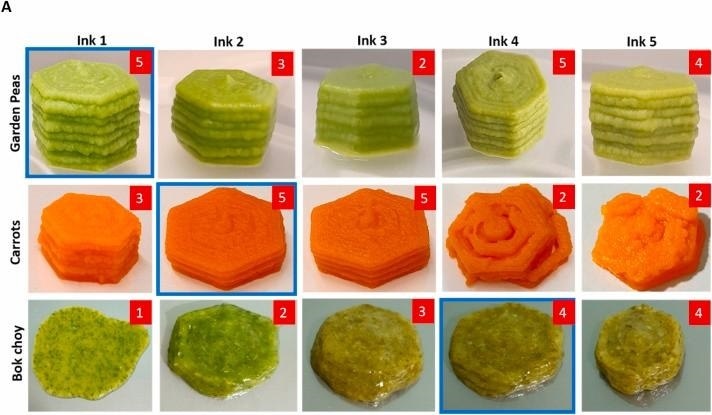Scientists from Nanyang Technological University, Singapore (NTU Singapore), Singapore University of Technology and Design (SUTD), and Khoo Teck Puat Hospital (KTPH) have created a novel method in which fresh and frozen vegetables are used to produce “food inks.” These inks preserve the flavor and nutrition better than the current techniques.

Representative images of 3D printed shapes with five formulations of one food ink type, images with a box drawn around them represent the optimized formulations of the inks. Print scores represented on the top right corner assessed by shape fidelity and shape stability. Image Credit: Singapore University of Technology and Design/Nanyang Technological University, Singapore/Khoo Teck Puat Hospital.
Food inks are commonly produced from pureed foods in semi-solid or liquid form, then these inks are 3D-printed by extrusion from a nozzle, and organized in a layer-by-layer fashion.
Pureed foods are generally given to patients who experience swallowing difficulties, called dysphagia. Healthcare professionals have utilized silicone molds to shape pureed foods so as to present the food in a more visually appetizing way. But this process is time- and labor-intensive, and need storage.
Although 3D food printing implies food can be simply produced in a required shape and texture in a shorter period, the dehydrated food and freeze-dried powders used as food inks generally contain a high percentage of food additives like hydrocolloids (HCs) to stabilize the ink and allow a smoother printing process.
High levels of HCs generally alter the aroma, texture, and taste of the printed food, rendering it unappetizing to patients suffering from dysphagia. This may result in decreased food consumption and malnutrition among these patients.
To deal with this challenge, the researchers investigated several combinations of fresh and frozen vegetables to stabilize the food inks. They preserved the nutrition of the printed food more optimally and also made it tastier. This new technique of making food inks is believed to boost meal consumption by patients and contribute positively to their mental state of mind and physical health.
The team also found that vegetables could be widely classified into three categories with each vegetable needing a different hydrocolloid treatment to become printable. For example, bok choy, carrot, garden pea, and bok choy were selected as representatives in all the categories, eliminating the need for HCs, one type of HC, and two types of HCs, in that order, as shown in the above image.
Our technology helps to provide dysphagic patients with adequate nutrient-rich and safe diets. Their feeding is more dignified, enabling them to socialise and consume meals that look, feel and taste like regular food.”
Yi Zhang, Principal Investigator and Professor, Nanyang Technological University
Professor Zhang continued, “Our method of 3D printing fresh vegetables can be used easily in hospitals, nursing homes, daycare centers for the aging population with dysphagia and other swallowing disorders. Our research is also another step forward in digital gastronomy, where we can cater to specific requirements prescribed by dieticians, such as nutrition customization and visual appeal.”
The next frontier of additive manufacturing is 3D food printing. As the 3D food printing landscape is increasingly evolving, we are excited to continue pushing the boundaries of this industry to find innovative solutions for global issues such as food security and sustainability.”
Chua Chee Kai, Study Corresponding Author and Head of Pillar, Engineering Product Development, Singapore University of Technology and Design
Chee Kai is also a professor at the Singapore University of Technology and Design.
3D Food Printing is more than a novelty. I believe it will be a viable approach in the near future in providing sustenance and nourishment to our increasing ageing population. Our frail, elderly patients as well as those with swallowing difficulties will be able to enjoy a visually presentable and pleasurable dining experience even with a restrictive diet of smooth pureed dishes.”
Gladys Wong, Co-Principal Investigator and Senior Principal Dietitian, Khoo Teck Puat Hospital
Source:
Journal reference:
Pant, A., et al. (2021) 3D food printing of fresh vegetables using food hydrocolloids for dysphagic patients. Food Hydrocolloids. doi.org/10.1016/j.foodhyd.2020.106546.